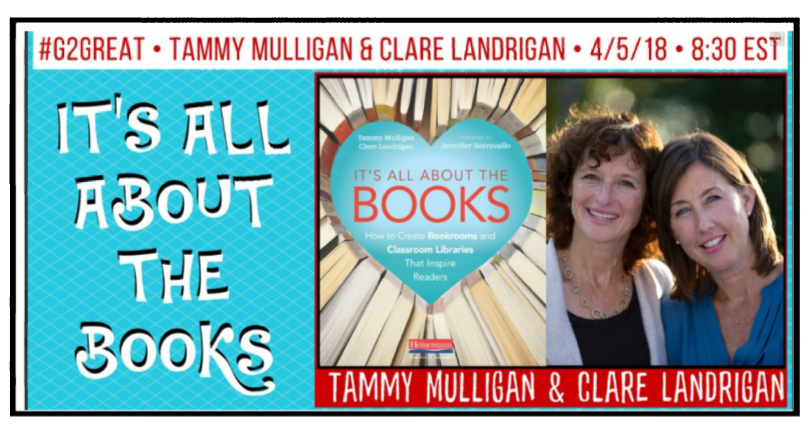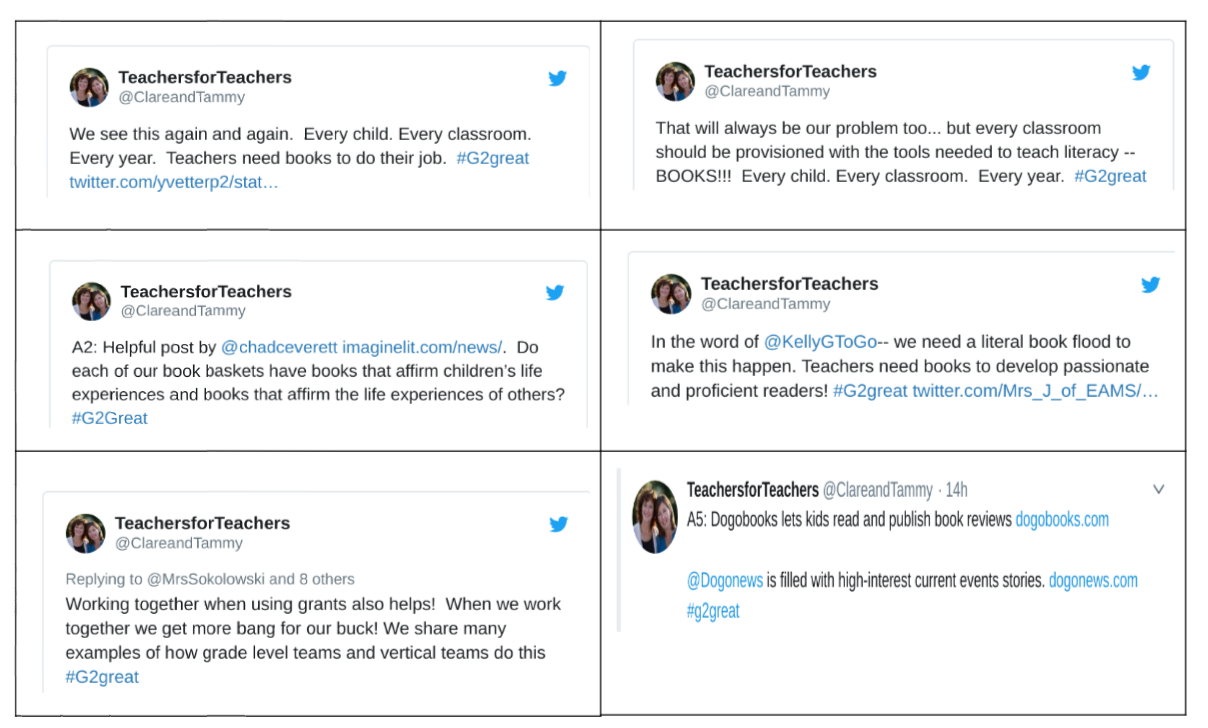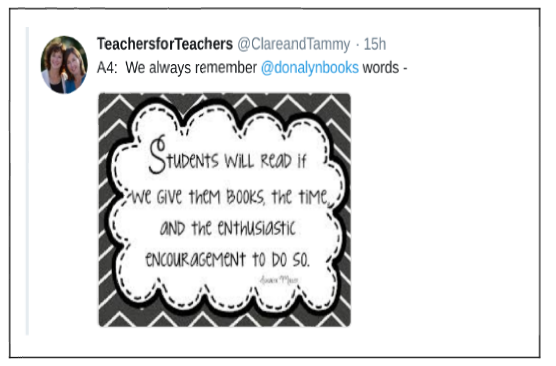By Fran McVeigh
Make no mistake about it. This book, It’s All About the Books: How to Create Bookrooms and Classroom Libraries That Inspire Readers, is about making sure that ALL students have access to books. And our #G2Great chat with guest hosts Tammy Mulligan and Clare Landrigan was trending within seven minutes of the opening tweet on April 5th. The pace was fast, furious, filled with the famous (Kylene Beers, Laura Robb, and Penny Kittle to name a few), and packed with powerful learning. As participants, we were given guidance and flexibility through the talented wisdom of Tammy and Clare (and the experts that they base their work on) that would also allow us to insert our own vision and passion to meet the needs of students in our classrooms across the continent. Neither the chat nor the book is about meeting proficiency levels (although books are the appropriate tool) or choosing a set list of books (your student needs will vary), but were both focused on many critical aspects of developing book collections. This post will focus on just two of them: Access and Design.
What does access to books mean for classroom libraries and bookroom collections?
Every student deserves quality books that he or she can read in order to be a reader. Books are the tools of readers. Access to books cannot be left to chance. That means that within a school building every student needs access to a classroom library and probably some form of a collaborative collection in a bookroom in addition to the school library. When access to books is a priority, every first year teacher will walk into a classroom full of chairs, desks, and tables that also has a classroom library that is fully-stocked. The teachers and administrators understand and believe that when students read a lot – both texts they choose and can read – they will become lifelong readers, and that classroom library is an indicator of the strength of their belief. A final element of access will reflect that the collection will “grow and extend” with the students. The books that are the focus at the end of the year may be totally different from the books that were in the library on opening day. Some books will remain constant but many other books will be replaced as students outgrow themselves as readers and demand different topics and types of books as the school year evolves.
What is the benefit for the students?
Books will be celebrated and students will know that one goal is to build a reader’s identity so some books will match the students. They will see themselves in the books and will also be able to see all the other members of their community. Each student will have access to the number of books that they need at school and at home that is necessary for him/her to be an engaged and inspired reader. Students will talk about their books with peers and adults. Students will also have a great deal of choice in what they read as well as when and where they read. Their days will be filled with opportunities to spend extended time reading so that being “lost in a book” is a routine habit. Because we also know that book choice is personal, not every student will want to read the exact same book. Opportunities for choice will need to be encouraged on a regular basis in order to develop and strengthen the habits of readers. Many books will be needed. Tammy and Clare tell us:
“Books are our tools to develop lifelong readers. The only way to merge true choice and accessibility is to have options and lots of them!” (Heinemann, It’s All About the Books, p 12)
What is the benefit for the teachers?
Every teacher will have access to books necessary to meet the needs of their students. These books will match the purpose: whole group, small group (guided or strategy), partner, and independent reading as well as instructional needs: Read Alouds, writing mentors, science content and/or social studies content. Access to quality books will enhance instruction and engage and inspire students. Access coupled with equity will mean that classroom collections will no longer be dependent upon teachers personally funding their own classroom libraries.
In order to achieve this access, all teachers will be expected to work collaboratively to identify the existing inventory of books available in the building and then strategically plan for the best use. What does that mean? Perhaps there are six packs of guided reading books that are gathering dust in current guided reading libraries. Maybe they could be better utilized if they were inserted into classroom libraries or set up for book club usage or even independent reading. Specific gaps in types of books that students like and want to read can be addressed systemically after establishing priorities and developing an organized purchasing plan. Teachers with access to a wide range of books will be able to share their own passion, agency, and that sense of inquiry that exists in their own reading lives without the pressure of being personally responsible for provisioning every book the students read.
Selected Tweets about Access:
Why is design important for classroom libraries and bookroom collections?
In the book, the chapter about design begins with a Steve Jobs quote:
“Design is not just what it looks like and feels like. Design is how it works.”
This means that in order for the books to be effective learning tools, there will need to be many books. Tammy and Clare offer suggestions on how to calculate the number of books that must be available for students at each grade level. Do involve the students in decisions because they will be a part of “how it works.” Don’t quit because you are discouraged by the staggering number of books needed because, Tammy and Clare also say:
“When teachers share texts and rotate inventory, stocking a school with authentic literature is a very affordable option. It truly is more bang for your books.” (p. 83)
#1 Design Issue: What to do with Book Levels
Much has been written about book levels by such literacy giants as Fountas and Pinnell, Donalyn Miller, Kylene Beers, and our own Dr. Mary Howard. I love the phrase “Intent vs. Impact” that Tammy and Clare use in their book and in their podcast. Levels are instructional tools that are intended to be guides – not absolutes and definitely not to limit a student’s access to books. (But wait a minute, access was the last section!) Levels are not going to define a child’s reading so levels will not be the ORGANIZER for books which brings us back to design. Some questions to be answered are: How will books be organized? How will they be displayed? Which books?
What is the benefit for students?
Taking book levels off of shelves and baskets does not meant that “anything goes” just as access doesn’t mean that students can only read a “Level H” for example. Middle ground means that book baskets can be organized by “concepts or ideas” such as “LOL” and the books in the LOL basket on the top shelf may be A-B, while the books in the LOL basket on the second shelf may be C-D, and the books in the LOL basket on the third shelf may be E-F. Students have access to any of the baskets but when they are choosing books that they can read independently, they can first decide on content: animals, friends, LOL, etc., and then check out the basket on the shelf that they are typically reading from. No one will ever say, “Now, Johnny, what level should you be reading?” Instead the conversation about books will be around the content and the strategies/skills/habits that the student uses as they tackle the books. Book levels will be inside the front cover or on the back cover, but they will not be the FIRST decision when choosing a book.
What is the benefit for teachers?
Teachers will need to know the qualities of the levels, not to define students but to know just which book will be the next “ladder” for instruction, which will be a challenge or stretch, and which will be “just right”? This actually gives the teacher more flexibility because it is easier to drop a level or two for beginning work with a more difficult skill without causing student or parental panic. With practice students can quickly move through appropriate books for the WORK they are engaging in rather than the “But I’m supposed to be reading H books!” that often currently surfaces.
Students can also be active participants in the book organization and the design of the classroom library so this means less work for the teacher. The classroom community can work together to create their own categories as they help curate the collection. Their “work” will also enable them to better appreciate the scope of the classroom collection. I’m always amazed when I’m in a classroom and students from another grade quietly step in, select a book from behind the teacher’s desk, and return to their own classroom. It’s important to know where those “book floods” exist that students actually have access to when they are in search of their next great book.
Shared teacher design is accomplished with the use of a bookroom or collaborative collection that helps provide the volume, range and choice that matches students’ interests. This collection exists to supply access to a world of ideas for students when they need them. Classroom libraries can easily be refreshed or rotated each quarter or each major school break so the teacher has a more ready supply of books available without a run on Amazon, Scholastic or other book sources. Sharing texts and especially series books makes provisioning libraries with authentic literature much more affordable. A five year purchasing plan, prioritized by gaps, can stretch farther than an individual teacher’s purchases.
Selected Tweets About Design:
All proceeds from the sale of this book will go #BookLove to fund elementary or middle school classroom libraries as explained in the following two tweets:
Books are the mainstay of student learning. Students gain such a feeling of accomplishment as they name that first book they can read or write. Literacy identities are important. This book, this chat, and the additional resources posted below literally add to our own passion for books, our “book love”, Reading is important because it improves our communication skills and enables us to learn about places and people that we may never see. It also helps build vocabulary and writing skills as we communicate better and even become better persons. Books can help us with all of those skills and this book, It’s All About the Books, by Tammy and Clare can help us inventory, prioritize and develop a plan to further extend our budgets and ultimately our learning! This book gives you a proven process, with a ten year track record, that will help you maximize your resources for increased student and teacher access and design and organize all those resources in your classrooms and bookrooms.
And if you already have Access and Design under control in your classroom libraries and bookrooms, there are many other chapters that deal with: Why a bookroom? Where to find diverse books? Technology? How are “Texts” defined? What about summer school access? Tammy and Clare will guide you through all the answers!!
Check out these Additional Resources
| Events | Heinemann Publications Live Facebook with Tammy and Clare
Wakelet/Storify from #G2Great chat April 5 Podcast with Tammy and Clare |
https://hubs.ly/H0byPMq0
|
| On the blog | Slice one – “A Reader Reminds Me”
Slice two – “The Power of a Book” |
|
| Print Resources | It’s All About the Books – Heinemann webpage
Sample Chapter |
goo.gl/CNxQpw |






This is such a powerful post on a topic that should be at the very center of all of our discussions Fran. As your post and this book so eloquently remind us, books are the beating heart of all we do in our schools and should be a focus of discussion and collaboration. Yet few schools are intentionally having these conversations and so many classrooms are still remarkably devoid of books – or they are organized in such a way that they are not accessible to kids (or designed to tether to a leveled bin without consideration of choice). It’s All About Books combined with your wonderful post will help teachers consider the most essential starting points. But more than that, these things will give our teachers the WHY we must make book conversations our first priority in every school.
Thanks, Mary.
Tammy and Clare’s book will allow teachers and administrators to take stock of the books that they value and take action to increase access and use of those books. School priorities will quickly prevail as plans develop to fill those gaps in teacher owned books in classrooms and bookrooms. Resources abound and I can’t wait to share these gorgeous ideas with students and teachers. This book would be so perfect for preservice courses!